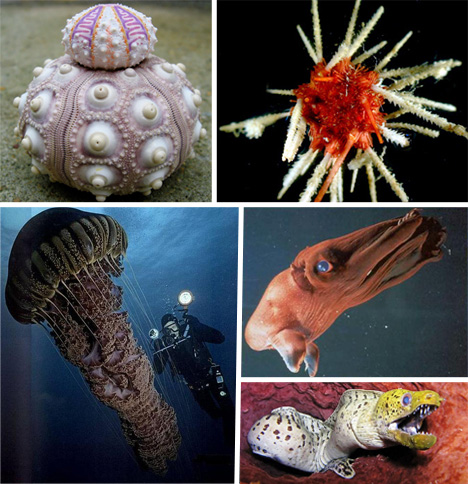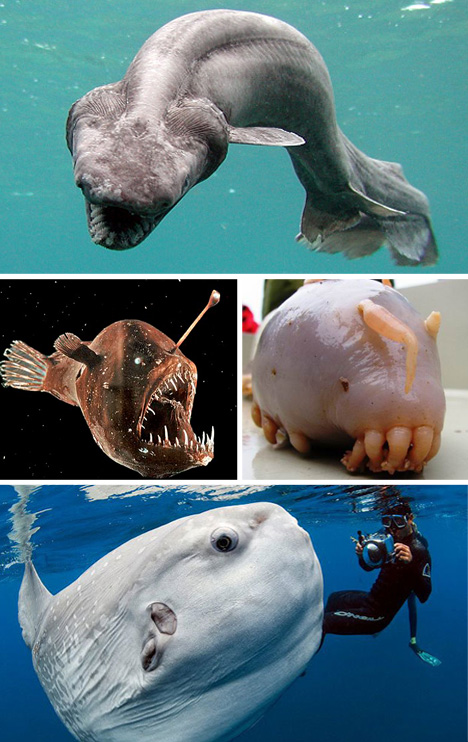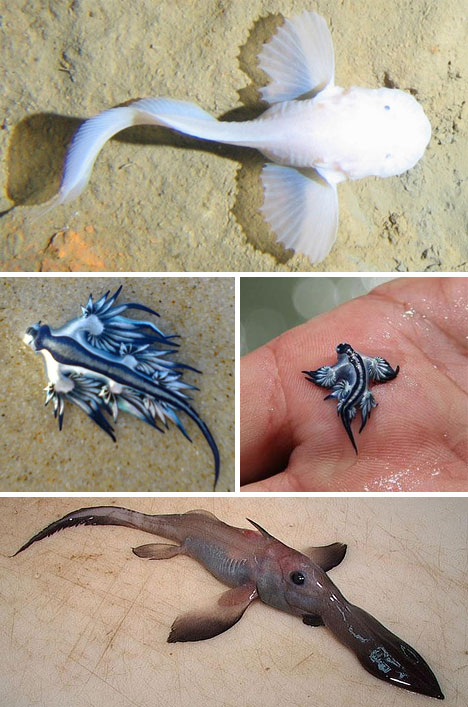
Tuesday, 25 September 2012

(Images via rocketboom, thetruthbehindthescenes, yahoo, whentalking)
The Frilled Shark is straight out of a horror movie, and was thought to be extinct until one was found in shallow water in 2011 (the previous sighting had been a dead one, in the 19th century). The wild looking Sea Pig is actually a type of sea cucumber. This Ocean Sunfish (known as a Mola Mola) can weigh up to 2,200 pounds. This fearsome looking Anglerfish dangles its bioluminescent light to attract prey towards its gaping jaws.
(Images via mongabay, oceancaresolutions, listverse, seaslugforum)
This snailfish’s fins look wing-like and majestic, but the only flying it will do is 7,000 feet underwater. The Glaucus Atlanticus Sea Slug, pictured twice above, is breath-taking, and really really small. It certainly looks cute compared to the Long-Nosed Chimera, which surfs along the ocean floor using its nose to gather up prey in the sand.
(Images via thedailygreen, seasweetie, wikipedia, uncommondescent, weird-funnythings)
The Kiwa is a blind, furry crab that resides 5,000 feet below the surface of the ocean. As unusual as it appears, for sheer terror it’s better to take a look at the Japanese Spider Crab, which can grow as long as 12 feet from leg tip to leg tip. Thankfully these critters roam the ocean floor and don’t get out on the beach much. This blind lobster is a great example of creatures that look similar to those we’re familiar with, but have creepy adaptations to help them survive in the dark depths. The giant isopod pictured above looks like it could have stepped straight out of a time warp from millions of years ago, yet it is an abundant species on the ocean floor.Firefly Squid
The Firefly Squid is a small, deep-sea squidThe firefly squid is a small member of the squid family, growing to a length of only three inches (seven centimeters). The squid is equipped with special light-producing organs called photophores. These photophores are found on many parts of the squid's body and emit a deep blue light
Images of Firefly Squid when it's glowing
AMAZING PHOTOGRAPH OF FIREFLY SQUID
The
glowing firefly squid are pushed to the shore's edge by the current
while spawning in the bay of Toyama, Japan... "The spawning season of
the firefly squid runs from March to May. During this time, the squid
can be seen gathering in large numbers in Toyama Bay in Japan. They
gather here by the millions, and sometimes by the billions, to lay their
eggs. Once the eggs have been released into the water and fertilized,
the adult squid begin to die. This completes the one-year life cycle of
the squid. This annual light show is so spectacular that the area where
they gather has been designated as a special natural monument. Toyama
Bay lies above a deep, v-shaped canyon in which the sea floor drops away
suddenly. The flow of the ocean currents usually wells up from the
bottom of this canyon and pushes the squid to the surface. Occasionally
the squid can be found washed up on the shore in large numbers during a
phenomenon referred to by locals as 'squid drowning themselves'. This
event can cover the shoreline for miles, bathing the beaches in an erie
blue glow."
ANOTHER PHOTOS OF FIREFLY SQUID
People most often see Oarfish washed up on beaches.
Encounters with live Oarfish are rare. They are sometimes seen on the
surface, and this may contribute to tales of sea serpents.
 Regalecus glesne Ascanius, 1772
Regalecus glesne Ascanius, 1772 Two 3 m long Oarfish washed ashore at Texel island, The Wadden islands,The Netherlands, May 2009.
The Oarfish is reported to be the longest of all fishes. It has a ribbon-like body that has been reliably documented to grow to 8 m in length, however specimens up to 17 m in length have been reported.
It is metallic silver with blotches and wavy markings on the body, and pink or red fins (Oarfish colouration page).
This species has a concave head profile and a highly protrusible mouth (a characteristic of the order Lampridiformes). It has a dorsal fin that runs the entire length of the body, but lacks an anal fin. There are tiny spines projecting laterally off each caudal and pelvic fin ray.
The derivation of the common name is uncertain. It may refer to the oar-shaped body, or the long oar-like pelvic fins, or possibly to reports that as the fish swims the pelvic fins scull the water like oars.
The Oarfish is found worldwide in all tropical and temperate marine waters. It is thought to live at depths between 20 m and 200 m, where it feeds largely on invertebrates and fishes.
Although several species of oarfishes have been described, there is now believed to be only one species.
Categories: None
Black swallower
(Reader Contribution to 10 Horrible Deep Sea Creatures)
This is a black swallower. It has a big stomach which can swallow fish larger that itself!
The Goblin Shark Close-up
(Reader Contribution to 10 Horrible Deep Sea Creatures)
Goblin Shark. When it feeds the under jaws fully open and shoot forward (try to catch the video sometime on Discovery!)
Vampire squid

Long-nosed Chimaera

Coffinfish

Fangtooth

Dragonfish

Gulper Eel

Wednesday, 19 September 2012
wow...there are many life in the deep sea that i have not seen before..such as Fangtooth, Viperfish, Glass Squid and many life.. this life have been stay together with us for a long time ago but we all don't know the life have existence in the deep sea in all time...maybe life in deep sea have existence before we all come existence....
Subscribe to:
Comments (Atom)





